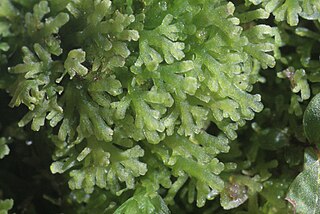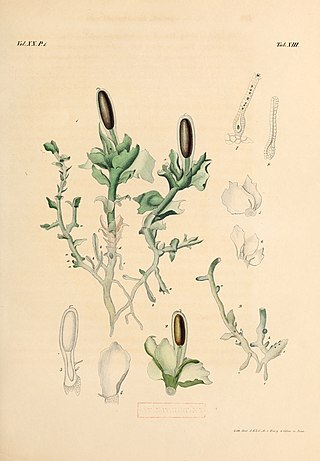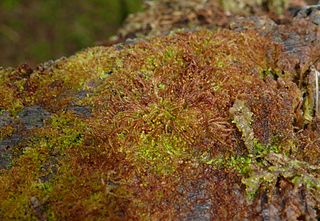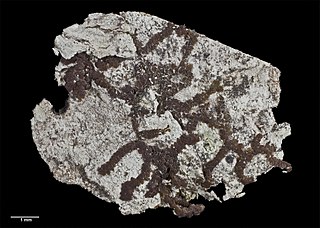
The Marchantiophyta are a division of non-vascular land plants commonly referred to as hepatics or liverworts. Like mosses and hornworts, they have a gametophyte-dominant life cycle, in which cells of the plant carry only a single set of genetic information.

Metzgeriales is an order of liverworts. The group is sometimes called the simple thalloid liverworts: "thalloid" because the members lack structures resembling stems or leaves, and "simple" because their tissues are thin and relatively undifferentiated. All species in the order have a small gametophyte stage and a smaller, relatively short-lived, spore-bearing stage. Although these plants are almost entirely restricted to regions with high humidity or readily available moisture, the group as a whole is widely distributed, and occurs on every continent except Antarctica.

Dendroceros is a genus of hornworts in the family Dendrocerotaceae. The genus contains about 51 species native to tropical and sub-tropical regions of the world.
Fulfordianthus evansii is a species of liverwort in the family Lejeuneaceae. It is found in Belize, Costa Rica, Guatemala, and Panama. Its natural habitat is subtropical or tropical moist lowland forests.
Haesselia roraimensis is a species of liverwort in the family Cephaloziaceae. It is endemic to Guyana. Its natural habitat is on rotten logs in periodically flooded riverine forest from 550 to 1,550 metres elevation, in the humid submontane tropical 'mossy' forests on the slopes of Mount Roraima, where the borders of Brazil, Venezuela, and Guyana meet.
Radula jonesii is a species of liverwort in the family Radulaceae, first described in 1988 from specimens collected in the Anaga Mountains of Tenerife. Endemic to Macaronesia, this dark to olive-green liverwort is known from five locations on Madeira Island and one location on Tenerife, where it grows as both an epiphyte on trees such as Laurus novocanariensis and as a lithophyte on shaded rocks in old growth laurel forest ecosystems between 800–1,000 m (2,600–3,300 ft) altitude. The species is distinguished by its procumbent growth habit, pinnately branched stems measuring 10–15 mm (0.4–0.6 in) in length, and distinctive cellular features including uniformly thin-walled leaf cells. Classified as Endangered due to its restricted range and small population size, R. jonesii faces threats from climate change, habitat degradation, and tourism pressure, though its habitat receives protection through various conservation designations including UNESCO World Heritage status.
Radula visianica is a species of liverwort in the family Radulaceae. It is endemic to the European Alps. It was thought to be extinct since 1938 but was rediscovered in 2014 in Austria.
Schistochila macrodonta is a endangered species of liverwort in the family Schistochilaceae. It is found in Bhutan and China. This large, unbranched liverwort, characterised by its shoots measuring 4–6 centimeters in length and distinctive two-lobed leaves with smooth margins, is found only in high-altitude temperate and subtropical forests of Bhutan and China's Yunnan Province, at elevations between 2,730 and 3,580 metres. The species has reddish-brown rhizoids and the unusual presence of bicellular propagules at its leaf tips. Its extremely restricted distribution, known from only a few locations spanning less than 500 square kilometres, has led to its classification as endangered on the IUCN Red List due to ongoing habitat decline.

Radula is a genus of liverwort in the family Radulaceae. The genus includes around 260 species of small plants that typically grow as green, scaly patches on tree trunks, logs, or rocks in moist environments. It is distinguished from other liverworts by several unique features, including the production of root-like structures (rhizoids) exclusively from leaf surfaces and characteristic branching patterns. The plants have rounded, overlapping leaves consisting of two unequal lobes, with considerable variation in structure across species. Following a major taxonomic revision in 2022, the genus comprises five subgenera with distributions ranging from tropical to temperate regions. The oldest known fossil species, R. cretacea from Burmese amber, dates to the Cenomanian age, though molecular evidence suggests the genus originated in the Triassic period, around 228 million years ago.

Haplomitriopsida is a newly recognized class of liverworts comprising fifteen species in three genera. Recent cladistic analyses of nuclear, mitochondrial, and plastid gene sequences place this monophyletic group as the basal sister group to all other liverworts. The group thus provides a unique insight into the early evolution of liverworts in particular and of land plants in general.

Perrottetinene is a naturally occurring cannabinoid compound found in liverworts from the family Radulaceae native to Japan, New Zealand and Costa Rica, namely Cladoradula perrottetii, Radula marginata and Radula laxiramea, along with a number of similar compounds. Its chemical structure closely resembles that of THC, the main active component of marijuana but with a cis rather than trans conformation and a bibenzyl tailchain instead of pentyl. The absolute configuration of perrottetinene was established in 2008 by an enantioselective total synthesis.

Ptilidium is a genus of liverwort, and is the only genus in family Ptilidiaceae. It includes only three species: Ptilidium californicum, Ptilidium ciliare, and Ptilidium pulcherrimum. The genus is distributed throughout the arctic and subarctic, with disjunct populations in New Zealand and Tierra del Fuego. Molecular analysis suggests that the genus has few close relatives and diverged from other leafy liverworts early in their evolution.

Riella is a genus in the liverwort family Riellaceae, and includes about eighteen species. Plants in the genus are small and grow submerged in shallow temporary pools. Although the genus is widely distributed in the Northern Hemisphere, locating populations is often difficult. Its occurrence is sporadic and local, and the tiny plants are ephemeral. The ornamented spores remain viable for several years, allowing the plants to survive annual drying of their habitat. The plants are easily grown in laboratory cultures.

Lejeunea hodgsoniana is a species of liverwort in the family Lejeuneaceae. Endemic to New Zealand, it was first recognized in 1980 but not formally described until 2013. The plant forms bright green mats up to 7 centimetres in diameter on tree bark and occasionally on rocks. The species is found from the Kermadec Islands in the north to the Chatham Islands in the south, primarily in coastal and lowland areas below 100 metres elevation. It is distinguished from related species by its relatively large size, multi-celled tooth on the leaf lobule, and deeply divided underleaves with pointed tips. While showing a particular affinity for mahoe trees, it grows on various native and introduced trees and is considered "Not Threatened" under the New Zealand Threat Classification System due to its abundance within its range and ability to grow in both pristine and disturbed habitats.

Radula demissa is a species of liverwort in the family Radulaceae. It occurs in southeastern Australia and New Zealand, where it grows as an epiphyte in temperate rainforest environments.

Nowellia curvifolia is a species of liverwort belonging to the family Cephaloziaceae. It is a small, delicate plant that forms prostrate growths on rotting logs in forests throughout the northern temperate and subarctic regions. The species is distinguished by its distinctive billowed leaves arranged in two rows, each divided into two pointed lobes with the lower lobe forming a specialised water-holding pocket called a water-sac. The plant shows seasonal colour variation from rose to purple to brown to spring green, developing reddish-purple pigmentation in autumn and winter. It reproduces both sexually, through spores produced in reddish-brown capsules, and asexually via single-celled gemmae. N. curvifolia serves as an indicator species in forest ecosystems, particularly in montane spruce-fir forests, where it often forms pure mats on decorticated logs and is associated with the slime mould species Barbeyella minutissima.

Frullania wairua, the spirit liverwort or radar bush liverwort, is a species of liverwort in the order Porellales. It is one of 24 species in the large genus Frullania that are native to New Zealand. The species was first described by Matt von Konrat and John E. Braggins in 2005 in the New Zealand Journal of Botany.
Cladoradula is a genus of liverworts in the family Radulaceae. Distinguished by its thick, brown-pigmented stems and distinctive branching pattern, it comprises seven species found primarily in tropical and temperate forest regions worldwide. Originally established as a subgenus of Radula in 1885, it was elevated to genus rank in 2022 following molecular studies that revealed it represents one of the oldest lineages within Radulaceae, having diverged during the late Permian period about 263 million years ago. The genus is characterised by its specialised stem structure, distinctive leaf arrangement, and small protective structures around its reproductive organs. Species in the genus grow as epiphytes on tree bark or shaded rocks from sea level to over 2,000 m (6,600 ft) in elevation.











